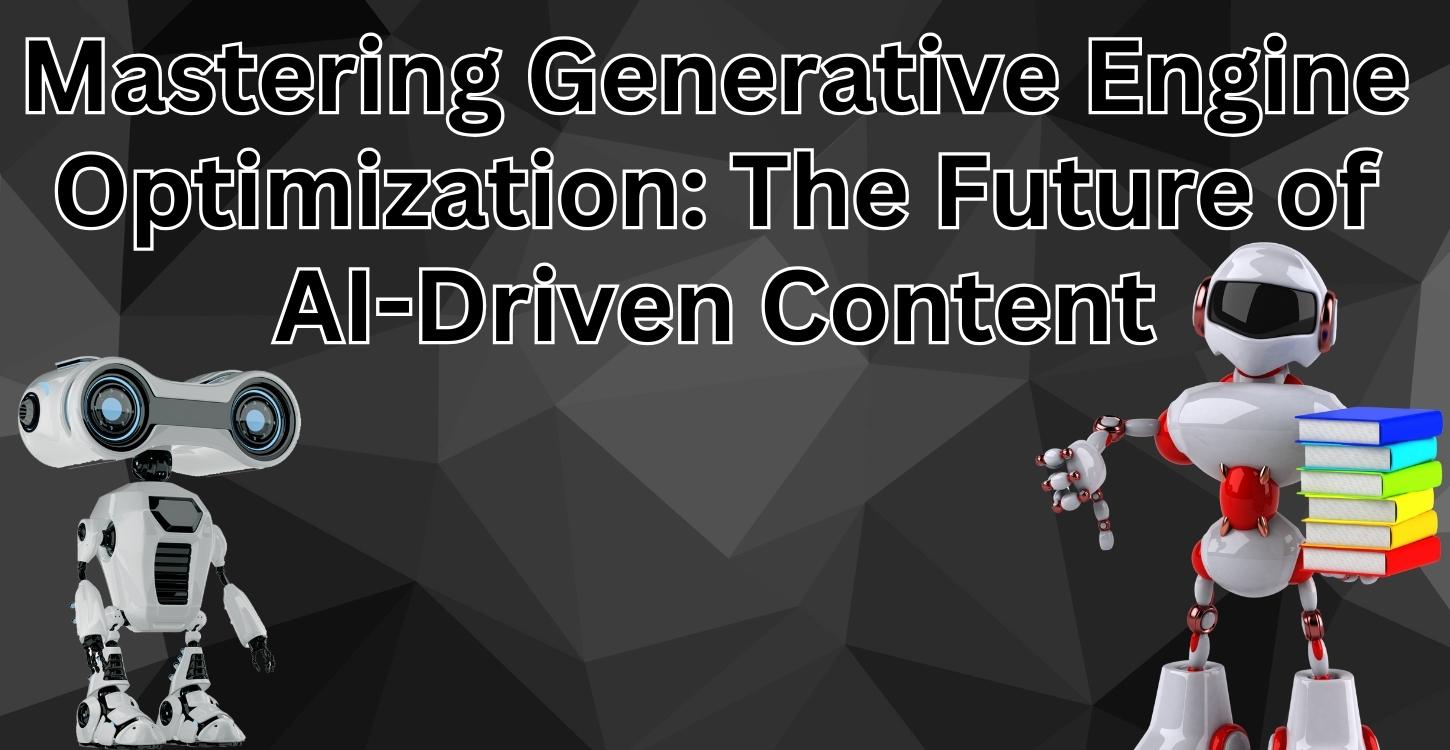Introduction: The Rise of Generative Engines
In recent years, digital content creation has undergone a transformation, fundamentally changing how businesses and individuals approach online communication. The rise of Generative Engine Optimization (GEO) has led to the ability to automate much of the content production process, from text and images to videos and even complex data visualizations. Generative engines, optimized through GEO techniques, are powerful tools designed to create content based on vast amounts of information and pre-set rules, making it easier to produce high-quality material faster than ever before. This optimization allows for more accurate, relevant, and engaging content that aligns well with audience preferences.
1.1 Evolution of AI-Driven Content
Content creation has evolved significantly over the last few decades. Initially, the internet was dominated by static pages with manually written content. As technology advanced, tools emerged to help writers optimize content for search engines, but this still required extensive human effort. With the development of automation systems, content generation entered a new phase. These systems could analyze large datasets and produce coherent content that was relevant to specific user needs. This automation transformed the way businesses operated online, allowing them to reach larger audiences with less effort.

1.2 Defining Generative Engine Optimization (GEO)
Generative Engine Optimization, or GEO, is the practice of fine-tuning generative engines to create content that meets specific goals. Whether the goal is to rank higher in search engines, engage a target audience, or deliver highly personalized material, GEO focuses on optimizing how engines produce this content. This optimization process ensures that the generated content is not only relevant and engaging but also aligned with broader business objectives. GEO is rapidly becoming a cornerstone of content strategy, helping companies deliver the right message to the right audience in a fraction of the time it once took.
1.3 The Importance of AI in Content Creation
As the demand for fresh, relevant content increases, the need for efficient creation methods grows as well. Traditional content production can be time-consuming, requiring multiple rounds of editing, research, and formatting. This is where modern technology steps in, offering tools that streamline the process. By automating repetitive tasks and providing insights based on user behavior, these systems allow creators to focus on strategy and creativity. The result is a more dynamic content ecosystem, where companies can produce material that is not only informative but also highly tailored to the needs of their audience, ensuring better engagement and higher conversion rates.
Understanding Generative Engines and Content Models
Generative engines are revolutionizing how we create digital content, from text and images to complex data visualizations. These engines are designed to analyze vast amounts of data and produce coherent, creative content based on specific instructions or patterns. But how do they work, and what technologies make them so powerful?
2.1 How Generative Engines Work
Generative engines work by using patterns found in existing content to create something new. They learn from large collections of text, images, or other data and understand how to piece together different elements into a finished product. For instance, to write an article or generate an image, the engine looks at numerous examples, identifying common themes, phrases, or shapes. Then, when asked to produce new content, it uses these learned patterns to create something original. These engines operate quickly, processing huge amounts of data in seconds, and can generate content based on specific instructions, making them incredibly useful for creating material tailored to individual needs.
2.2 Key Technologies Behind Generative Engines
The backbone of generative engines is made up of several key technologies. First, there’s data processing, which allows the engine to analyze vast datasets and identify useful patterns. Then, we have machine learning techniques, which help the engine learn from the data and improve its performance over time. Additionally, neural networks, which mimic the way the human brain works, play a crucial role by enabling the engine to make complex connections between different pieces of information. Finally, there’s reinforcement learning, where the engine improves through trial and error, continuously refining its output to meet the desired outcome.
2.3 Popular Models for Content Generation
Several well-known models are used for creating content, each excelling in different areas. For instance, some models specialize in generating text, creating coherent and engaging writing based on minimal input. Others focus on images, producing detailed visuals from just a few instructions. These models are widely adopted by companies and creators for tasks ranging from writing blogs and articles to creating visuals for marketing campaigns.
2.4 The Role of NLP and Computer Vision in Content Creation
Two major technologies that drive the effectiveness of generative engines are Natural Language Processing (NLP) and computer vision. NLP enables engines to understand and generate human-like text, making it possible to write with natural flow and readability. On the other hand, computer vision allows engines to analyze and create visual content. These two technologies work together to ensure that the content generated—whether text or visuals—is relevant, engaging, and aligned with the user’s expectations.
The Fundamentals of Generative Engine Optimization (GEO)
As digital content creation continues to evolve, the need for more efficient ways to optimize and personalize content has given rise to Generative Engine Optimization (GEO). GEO focuses on fine-tuning the tools used to create content so that they produce high-quality material tailored to specific business objectives and audience needs.
3.1 What is GEO?

Generative Engine Optimization, or GEO, is the process of optimizing generative engines to produce content that is relevant, engaging, and aligned with specific goals. It involves adjusting the engine’s settings and guidelines to ensure that the content it generates meets criteria such as tone, style, keywords, and target audience preferences. By implementing GEO, businesses can ensure that the content created by these engines isn’t just generic but is purposefully crafted to maximize impact.
3.2 Key Concepts and Terminology in GEO
Several key concepts are important in understanding GEO. One of them is content relevance, which ensures the generated material is meaningful to the audience. Another is contextual accuracy, which means the content fits the situation, topic, or theme it’s meant to address. Customization is also essential, allowing businesses to shape content to their specific brand identity and voice. Additionally, automation is a concept in GEO, where repetitive tasks are streamlined, freeing up time for strategic planning.
3.3 GEO vs. Traditional SEO: What’s the Difference?
While traditional Search Engine Optimization (SEO) focuses on improving the visibility of manually created content in search engine results, GEO is all about optimizing the content generation process itself. Traditional SEO relies heavily on keyword usage, backlinks, and metadata to boost rankings, whereas GEO enhances the actual creation of content, ensuring it is naturally aligned with the needs of search engines and users from the start. While SEO is reactive—optimizing content after it’s written—GEO is proactive, optimizing content creation from the outset.
3.4 Why GEO is Critical for Future Content Strategies
As the digital landscape grows more competitive, GEO will play a crucial role in the future of content strategies. With an ever-increasing demand for personalized, high-quality material, businesses will need to leverage content engines that can keep up with the pace while delivering unique, audience-specific material. GEO allows businesses to produce content faster and more efficiently without sacrificing quality, enabling them to stay ahead of the curve in a world that requires constant engagement and relevance. By adopting GEO, companies can scale their content efforts while maintaining consistency, enhancing both their search engine rankings and user satisfaction.
Building Optimized Content Strategies
In today’s fast-paced digital world, businesses must build content strategies that not only resonate with their audience but also keep up with the constant demand for fresh material. This is where optimizing content engines becomes vital. By aligning content creation with key insights and automation, companies can craft strategies that are both scalable and engaging.
4.1 Identifying Target Audiences with Insights
The foundation of any successful content strategy is understanding the target audience. Modern tools provide valuable insights into audience behavior, preferences, and demographics. This helps businesses tailor their content to meet the needs of specific groups, increasing engagement and relevance. By analyzing data such as search trends, social media interactions, and user behavior on websites, companies can create highly personalized content that speaks directly to their audience’s interests and pain points.
4.2 Generating High-Quality Content: Automation vs. Creativity
Balancing automation with creativity is crucial. While automation can speed up the content production process by handling repetitive tasks such as formatting, scheduling, or even drafting simple texts, creativity remains key in delivering unique, memorable content. The best strategies combine both—automation takes care of efficiency, while human input ensures the content stands out with a strong voice, creative storytelling, and a personal touch that resonates emotionally with the audience.
4.3 Leveraging Automation to Scale Content Production
Scaling content production can be challenging for businesses. However, with the right tools, companies can produce high volumes of content without sacrificing quality. Automated systems help by quickly generating articles, blog posts, product descriptions, and other materials that can be adapted for different platforms. This allows businesses to maintain a constant flow of relevant material across all their channels, ensuring they stay visible in a crowded online marketplace.
4.4 Personalization and Dynamic Content Generation
Personalization is the key to engaging users effectively. Instead of providing the same content to everyone, modern tools enable dynamic content generation, which adjusts based on user preferences, location, and behavior. This means a visitor from one region may see different content than someone from another, or that returning visitors are greeted with fresh, tailored material. Personalization ensures users receive the most relevant information, increasing their likelihood of engagement and conversion.
Optimizing Generative Engines for Search and User Engagement
Once content is created, the next step is ensuring it performs well in search engines and captures the attention of users. Optimizing content engines is crucial to achieving both these goals.
5.1 GEO and Search Engine Algorithms
Search engine algorithms are designed to rank content based on its relevance, quality, and authority. By optimizing generative engines, businesses can create content that is naturally aligned with these ranking factors. This includes incorporating relevant keywords, structuring content for easy reading, and ensuring the content addresses the user’s search intent. Generative Engine Optimization (GEO) ensures that content is primed for visibility from the moment it’s created, helping it rank higher in search results.
5.2 Improving Content Relevance
Relevance is one of the key factors in both search engine rankings and user engagement. For content to be relevant, it needs to address the specific needs and questions of the target audience. This means optimizing the way content is generated, so it’s not only packed with useful information but also structured in a way that is easy for users to digest. Content relevance can be improved by focusing on clarity, context, and addressing common user concerns or queries.
5.3 The Role of User Experience (UX) in Engagement
User experience plays a significant role in content engagement. If users find content hard to navigate, slow to load, or not visually appealing, they are less likely to engage with it, regardless of its quality. Optimizing content engines for user experience means ensuring that content is well-formatted, mobile-friendly, and structured for easy reading. This also involves enhancing interactive elements like videos, quizzes, or clickable links that keep users on the page longer, improving their overall experience.
5.4 Measuring Success: Key Metrics for GEO
To determine whether your content optimization efforts are successful, it’s essential to track specific metrics. Key performance indicators (KPIs) for GEO include search engine rankings, organic traffic, user engagement metrics such as time on page or bounce rate, and conversion rates. By regularly analyzing these metrics, businesses can adjust their strategies to continually improve content performance, ensuring that it remains relevant and engaging over time.
Advanced GEO Techniques and Tools
Generative Engine Optimization (GEO) is continuously evolving, with new techniques and tools emerging to enhance its effectiveness. By mastering these advanced strategies, businesses can ensure their content stands out in the digital landscape.
6.1 Keyword and Topic Optimization
A key element of advanced GEO is optimizing keywords and topics. Modern tools can analyze large volumes of search data to identify the most relevant keywords for your target audience. This enables content creators to build their material around topics that are trending or highly searched, ensuring greater visibility. By focusing on precise keyword placement and topic selection, businesses can improve their content’s relevance, helping it rank higher in search results and attract more organic traffic.
6.2 Enhancing Visual Content
In a world where visual content is just as important as written content, businesses must find ways to enhance their images, videos, and graphics. Advanced techniques allow for the creation of high-quality visuals that are personalized and unique. These visuals can be optimized to complement written content, creating a cohesive and engaging user experience. Infographics, product mock-ups, and other forms of visual storytelling are key to keeping audiences engaged and improving content appeal.
6.3 Tools for GEO: Platforms, APIs, and Software
There are various platforms and tools available to streamline GEO processes. These range from content creation platforms that offer pre-built templates and optimization features, to APIs that allow seamless integration of advanced content creation functionalities into your existing systems. Software tools can automate parts of the content generation and optimization process, saving time and ensuring consistency across different platforms.
6.4 Case Studies of Successful GEO Implementations
Learning from successful implementations of GEO is vital for growth. Businesses that have adopted advanced GEO techniques have reported increased engagement, improved search engine rankings, and higher conversion rates. Case studies from companies that have optimized their content generation strategies reveal the practical benefits of GEO, showcasing how it can be used to create more personalized, efficient, and impactful content.
Ethics and Challenges in Generative Engine Optimization
As with any powerful technology, GEO presents ethical challenges and risks that need to be carefully managed. Addressing these challenges ensures that content creation remains responsible and trustworthy.
7.1 Addressing Bias and Misinformation
One of the biggest ethical concerns is the potential for bias or misinformation in generated content. If an engine is trained on biased data or inaccurate information, it can perpetuate harmful stereotypes or produce misleading content. To counter this, businesses need to ensure that the data used to train engines is diverse and factual. Regular audits and updates to data sources can help mitigate bias and reduce the spread of misinformation.
7.2 Navigating Copyright and Legal Concerns
Another critical challenge is the issue of copyright and intellectual property. Content generated using existing data must respect copyright laws, which can be tricky when sourcing material from various platforms. Businesses need to be mindful of where their data comes from and ensure they have permission to use it, especially when generating content that closely resembles original works. Legal concerns can be navigated by establishing clear guidelines and ensuring compliance with intellectual property laws.
7.3 The Role of Human Oversight in Content Creation
While optimization tools are powerful, human oversight remains crucial in ensuring ethical standards are met. Human editors are needed to review and approve generated content, ensuring it aligns with a company’s values, tone, and quality standards. This balance between automation and human oversight ensures that the content remains accurate, ethical, and effective in communicating a brand’s message.
7.4 The Future of Ethical Content Creation
As generative engines continue to develop, there will be a growing need to address ethical challenges proactively. Businesses will need to invest in systems that prioritize transparency, fairness, and accountability in content creation. The future of ethical content will rely heavily on creating systems that can adapt to changing societal values while maintaining a commitment to producing unbiased, accurate, and creative content. By fostering a culture of responsibility, businesses can ensure that their content strategies are sustainable, trustworthy, and aligned with ethical standards.
The Future of Generative Engines in Content Marketing
Generative engines are reshaping content marketing by allowing businesses to create highly relevant and personalized content at a much faster pace. As technology advances, these engines will become more sophisticated, offering marketers a powerful tool to stay competitive in an increasingly digital world.

8.1 How GEO is Shaping the Future of Digital Marketing
Generative Engine Optimization (GEO) is becoming a driving force in digital marketing strategies. By streamlining the content creation process and optimizing it for specific audiences, GEO helps businesses produce material that directly targets their customer’s needs. This leads to increased engagement and higher conversion rates. The ability to quickly generate personalized content for various platforms—such as blogs, social media, and email campaigns—ensures that brands can maintain a consistent presence across channels. As GEO tools improve, marketers will rely more on these systems to meet the ever-growing demand for high-quality content, driving greater efficiency in digital marketing efforts.
8.2 Predictions for the Next Generation of Content Tools
In the near future, content generation tools will become even more intuitive and creative. We can expect tools that not only produce written content but also generate sophisticated visuals, videos, and interactive media based on minimal input. These tools will likely be integrated with customer data analytics, allowing businesses to automatically adjust their content to reflect real-time user preferences and behavior. As these tools become more advanced, businesses will have the ability to generate dynamic, multimedia content that keeps pace with rapid changes in consumer interests and market trends.
8.3 Preparing for the Content Revolution
To stay ahead of the curve, businesses need to start preparing for this content revolution now. This means investing in the right tools and technologies, training their teams on how to effectively implement GEO strategies, and keeping a close eye on industry trends. It also means focusing on building a content strategy that is adaptable, scalable, and forward-thinking. As content tools become more sophisticated, businesses that are able to quickly adopt and integrate these technologies will be better positioned to succeed in the evolving digital landscape.
Conclusion: Mastering GEO for Long-Term Success
Mastering Generative Engine Optimization is not just about keeping up with the latest trends—it’s about setting your business up for long-term success. By understanding how to optimize content generation processes and aligning them with business goals, companies can create meaningful, high-quality content that resonates with their audience. GEO offers a path toward more efficient, personalized content strategies that will drive better engagement, higher conversion rates, and improved brand loyalty. As generative technologies continue to evolve, those who embrace and refine their GEO strategies will be well-positioned to lead the future of digital marketing.


